Genre: Run-‘n-Gun Developer: Sega Ent. Publisher: Sega Ent. Players: 1-2 Released: 1986
The North American Master System library has no shortage of “me too” games brought out to compete with the NES. Some tread dangerously close to plagiarism, like Super Tennis, a shameless clone of Nintendo’s “black box” Tennis. Others, like Golden Axe Warrior, duplicate the gameplay of another title (in this case The Legend of Zelda) to the point where experience with one lets you jump right into the other, but at least they took the time to slap on a different skin.
At first glance, Rambo: First Blood Part II seems like an example of the latter. The methodical gameplay and slow-pivoting protagonist are strongly reminiscent of Ikari Warriors, so are smaller details like the ubiquitous flamethrower soldiers, or the rock formations that fire projectiles from their stony faces. And when grenades begin pelting you from off-screen, any Ikari veteran will instantly know you’re being punished for staying in one place too long.
However, one big difference is that, unlike Micronics’ horrific NES port of SNK’s arcade game, Rambo is actually playable, well-programmed, and even fun. True, you don’t get to drive a tank or a helicopter, but you’re also spared the endless torture of Ikari‘s painfully long stages. Instead you get six relatively compact and action-packed “rounds” in which a mix of pre-placed enemies and ever-spawning grunts beleaguer the hero. (or heroes: Rambo supports two-player simultaneous co-op, though I haven’t tried it much.)
To fight them off, you get an M60 with unlimited ammo (though its fire rate is anything but rapid), and in lieu of grenades, a quiver of five “arrow-bombs.” Use these to blow up the huts of nearby peasants, and in return they offer you… more arrow-bombs? Not sure how that works, but that’s video game logic for you (at least you’re not eating turkey legs from a garbage can). Or they’ll give you an extra life instead, which is handy since you only start with three, plus the automatic one-up you get at the end of each round.
Meanwhile, killing enough grunts will get you power-ups to increase the range or penetration of your gun. But be careful. If a gun power-up is onscreen, peasants won’t dispense arrow-bombs or extra lives. Is that a sprite limit rearing its ugly head? Well, that’s the price of a flicker-free game engine.
Early rounds take place in jungles and swamps and offer few surprises. Later, in a low-key callback to the films, you face bodacious cowboys, crawling police snipers, and highway patrolmen on motorcycles. Each stage ends with a “concentration camp,” i.e. fortress, where you have to kill a certain number of enemy grunts before the main gate becomes vulnerable to an arrow-bomb. (Perhaps the designers studied Commando too, since this device is pulled straight from Capcom’s game.) Last of all is a heavily fortified area plagued by the game’s most maddening foe, those damnable bouncing grenades. This final round concludes in a showdown with…
… a giant creepy face? That certainly seems like a blatant pull from Ikari Warriors, which ends in much the same way on the NES, but both games were released almost simultaneously in Japan, which rules out copycatting. And the arcade game’s ending is totally different, so that can’t be the source either. Apparently, it’s just a wild coincidence.
Speaking of “slapping on a different skin,” it’s probably time to mention that Rambo: First Blood Part II had completely different branding in other territories. In Europe it was Secret Command, aka Secret Commando on the title screen, with Stallone-free cut scenes (and pathetic box art) but the same gameplay. In Japan it’s titled Ashura, and the protagonists are now Buddhist monks. Beyond the cosmetic changes, there’s at least one gameplay difference in the Japanese release. Only explosive arrow-bombs can kill the flamethrower enemies, making Ashura slightly tougher.
In any version, Rambo gets no continues unless you use a cheat code. (No, not ABBA. There’s a different code for each stage.) Unlike many Master System games, these aren’t in the manual, making them off-limits for a player with integrity. As a result, Rambo is punishingly hard at first, and getting a GAME OVER in round one is by no means unusual. Newbies will be further vexed by Rambo’s total inability to face or fire backwards. Instead, pressing down makes him instantly face forward while moving backwards, which turns out to be surprisingly useful, and the closest thing you’ll get to strafing in a game of this vintage.
Rambo is very decent-looking for the time, with none of the garish palettes that plague early Master System releases. The music by “Wooper Katsu” (Katsuhiro Hayashi) is well-written but curiously somber. A tune like “Never to Return” lives up to its downbeat name, while the score as a whole emphasizes low pitches and minor keys, particularly D minor (and anyone who’s seen This is Spinal Tap knows what that means). Unlike the later Rambo III, no FM option is present, with or without hacks, but at least we avoid the shrill, tinny orchestration that afflicts some PSG soundtracks.
Odds are the combination of “licensed movie tie-in game” and “slow-moving Ikari Warriors clone” doesn’t have you racing for your controller. But I’ve beaten this game twice now, once as Secret Command(o) and once as Rambo, in two playthroughs a decade apart, and actually found it pretty addictive. The lethargic character movement gradually makes sense, as the game is designed around Rambo’s slowness, not in spite of it. And you need not memorize every detail of every area to make progress (though it doesn’t hurt), as cheap-shot bottlenecks are few and reflexes are often enough. It took me about five hours to beat the game the first time, and half that the second time, which seems about right for… well, let’s call it a walk-‘n-gun. So, despite first impressions, it’s really not too hard.
That said, Rambo isn’t perfect. I have a real affection for Hayashi’s oddly mournful music, and the graphics and stage design are effective, but there’s no denying that the glacial pace will put many players off. The game’s last act starts to go downhill, and I swore up a storm courtesy of those bouncing grenades, which are clearly a roadblock to extend the game’s shelf life. Instead of a satisfying challenge, the final boss fight offers up confusion and clutter: when my game-winning strategy involved manipulating the number of onscreen sprites, it’s a sign that something’s gone wrong.
Still, put it up against Nintendo’s offering, and Rambo: First Blood Part II comes out looking pretty good. Chances are, that was the point, -to go toe-to-toe with the NES port of Ikari Warriors, and Rambo acquits itself well. Throw in a bonus point for the two-player co-op, of which there’s not nearly enough on the Master System.
One final irony I didn’t know until writing this review: Ikari Warriors itself was originally supposed to be a Rambo game, but SNK failed to get the license in time. So now which one’s the ripoff? I don’t even know anymore , but I know which console game I’d rather play in 2021. The Master System didn’t always fare well in these 8-bit head-to-heads, but in this case, score one for Sega and Rambo.
SCORE: 8 out of 10

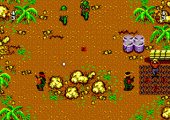
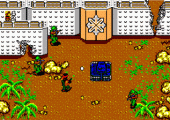
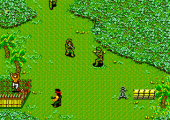
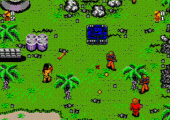
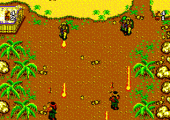
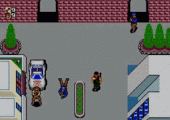
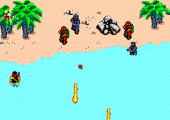
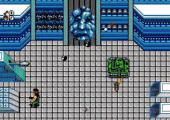
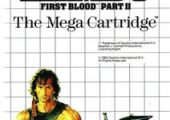
Recent Comments